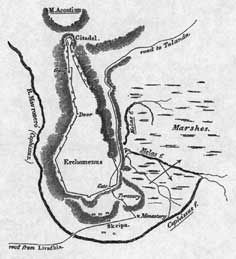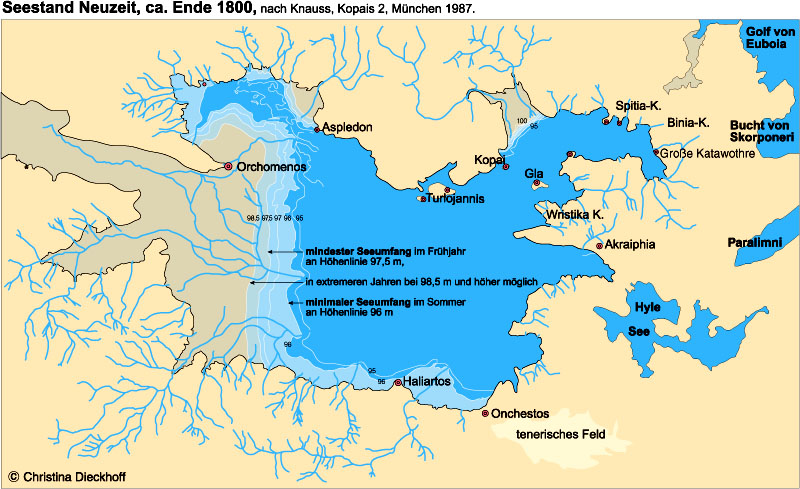|
|
Orchomenos
Überblick
Archäolog. Plätze
Geschichte
Mythen
Quellen
Sekundärliteratur
Abbildungsnachweis
Museen
Tourismus
|
|
|
Europäische Reisende in Griechenland am Anfang des 19. Jhdts.
Dodwell, Eduard:
Classische und topographische Reise durch Griechenland während
der Jahre 1801, 1805 und 1806, 2 Bde., Meiningen 1821, übersetzt
durch F.K.L. Sickler, Des ersten Bandes zweite Abtheilung.
Mit seinem Werk gibt er sowohl eine "..systematische Beschreibung
der Topographie Griechenlands als auch eine detaillierte Untersuchung
über die erhaltenen Zeugnisse der Antike." (Tsigakou, S. 26)
Dodwell, S. 14:
"Ich kenne keinen Platz, von dem der See Kopais nebst dessen Ebene
so schön und ausgedehnt vor den Blicken liege, als von der Akropolis
von Orchomenós. Wheler´s [1]
Beschreibung dieser Gegend ist so genau und umfassend, daß zu
demjenigen, was er gesagt, wohl nur wenig zuzufügen seyn dürfte."
Oberst William Martin Leake
besuchte Griechenland zum ersten Mal 1802. Die englische Regierung sandte
ihn 1804 auf eine diplomatische und militärische Mission, auf der
er die griechische Westküste erforschen, die türkischen Truppen
im Gebrauch moderner Artilleriewaffen unterweisen und freundliche Beziehungen
zu Ali Pascha herstellen sollte. 1815 kehrte er nach England zurück.
Er schrieb mehrere Werke über Griechenland, u.a. auch Travels in
Northern Greece, 4 Bände, London, 1835, aus deren Übersetzung
die nachfolgenden Zitate stammen. Wegen seiner präzisen Beschreibungen
wird Leake manchmal als der Begründer der wissenschaftlichen Geographie
in Griechenland bezeichnet [2]. Ausszüge
aus Travels in Northern Greece, London 1835, ND Amsterdam 1967, Band
II:
Brücke über den Kephissos – Skripú besteht
aus etwa 100 Häusern – Sumpf des Melas
Leake, S. 144/145:
"We now cross the opening of the vale of Chaironeia direct to Skripú,
cross the Cephissus by a bridge, and arrive at Skripú exactly
at noon. This village consists of about one hundred houses, standing
partly on the rocky base of the mountain, and partly on the river side
in the plain, just where, after having flowed along the southern side
of Acontium, it turns from an eastern to a north-eastern course, and
thence north into the marshes. Passing through the village, we proceed
to the monastery of the theotókos, situated a little beyond it
to the northward.

Zeichnung von Leake mit Verlauf der Flüsse
Kephissos und Melas (Abb. 26)
Orchomenus, like many other Greek cities, occupied the triangular face
of a steep mountain, at its rise from the plain ; and possessed in perfection
those advantages of position, which the Greek engineers generally sought
for, being defended on every side by precipities, rivers, and marshes."
Schatzhaus des Minyas nahe am Fluß – Hindernisse bei
Elgins Ausgrabungsversuch
Leake, S. 148:
"Some remains, which have every appearance of having belonged to
the last-mentioned building, are found to the eastward of the lower
wall, where the height terminates in a low projection which is separated
from the river by a level only a few hundred yards in breadth. The artists
employed by Lord Elgin attempted to excavate the ruins of the building,
but were deterred from making much progress by the large masses of stone
which presented themselves, and which they had not the means of removing.
As all the lower parts of the construction are buried in the ruins of
the upper, they will probably be found in situ whenever a complete exeavation
shall be made." [Diese vollständige Ausgrabung wurde dann
durch Schlieman durchgeführt.]
Kloster steht am Flußufer
Leake, S. 152:
"The monastery of Skripú stands about midway between the
treasury and the river, below the lowest slope of the hill, on a level
with the river's bank."
Quellen – Melas – See füllt ganze Nordost-Bucht aus
– Melas schiffbar
Leake, S. 154/155:
"Exactly at the foot of the precipitous rocks which formed the
limit of the northern side of the city, are the sources of the river
anciently called Melas, and now Mavropotami, synonyms derived apparently
from the dark colour of its deep transparent waters. Among several sources
there are two much larger than the others, and both considerable rivers.
One flows north-eastward, and at a distance of little more than half
a mile meets the Cephissus, which a little beyond the junction becomes
so enveloped among the marshes extending from thence to the heights
to the north-east, on which stands a tower called Xerópyrgo,
as to be scarcely traceable; but it re-appears in a single body about
three miles to the eastward of Skripú, and after flowing for
some distance in the direction of Kardhitza turns towards TopóIia,
where it enters the lake, which, in the present season fills the whole
of the north-eastern bay of the Cephissian basin.

Kopais etwa zur Zeit der Reiseschilderungen,
entnommen aus dem Kopais-Kapitel von Christina Dieckhoff.
Vergrößern
The other large source or branch of the Melas, which is to the westward
of the former, follows for a considerable distance the foot of the cliffs
of Orchomenus, and is then lost in the marshes. This illustrates Plutarch,
who, after having remarked that " the pIain of Orchomenus is the
largest and finest in Boeotia, but naked of trees and plants, except
towards the Melas," observes, that "this river rises below
the city of Orchomenus, and is the only river in Greece which is navigable
at its sources though it has not a long course [Schiffbarkeit durch
den Kanal, in den der Melas geleitet wurde], the greater part being
lost in impervious and muddy marshes, and the remainder uniting with
the Cephissus near the place where the lake produces the auletic reed.""
Flötenrohr
Leake, S. 156:
"The marshes still produce in abundance the reeds for which Orchomenus
was anciently noted. The auletic or flute-reed is described by Pliny
as very long, and without knots. Plutarch observes, that the best were
produced near the junction of the Cephissus and Melas."
Nahrungsreichtum des Sees wird von Anwohnern an diesem Ufer nicht
genutzt - Mönche schätzen Aale des Sees,
besonders zur Fastenzeit
Leake, S. 157:
"These and other peculiarities of the Cephissus it would be interesting
to examine more minutely, but not a single monóxylo is possessed
by any of the villages on this side of the plain. Hence the inhabitants
derive little or no benefit from either the vegetable or animal productions
of the lake and its surrounding marshes, though the monks of Skripú
describe all the watery parts as being covered at times with water-fowl,
and are fully aware of the excellence of those eels so renowned among
the ancient Athenians, and which the monks describe as large, white,
of delicate flavour, and light of digestion. They are taken in considerable
numbers by the people of Topólia in the permanent part of the
lake near that town, from whence, either fresh or salted, they are carried
for sale throughout rounding country, especially in the time of Lent
[3]."
(Peter Teuthorn)
Lesetipp:
Tsigakou, Fani-Maria:
Das wiederentdeckte Griechenland in Reiseberichtenund Gemälden
der Romantik
(mit einer Einführung von Sir Steven Runciman)
__________
[1] George Wheler (1650-1723) bereiste zusammen mit
Jacob Spon Griechenland im Jahr 1675. Veröffentlichte 4 Jahre später
seinen Reisebericht. Zitiert nach Tsigakou S. 191c.
[2] Vgl. Tsigakou: Das wiederentdeckte Griechenland,
S. 188, FN 28.
[3] Die Fastenzeit von Aschermittwoch bis einschließlich
Ostersamstag wurde und wird im orthodoxen Griechenland streng beachtet.
|
|

